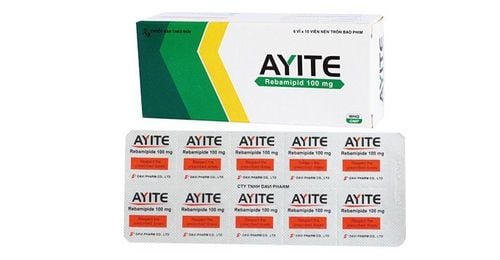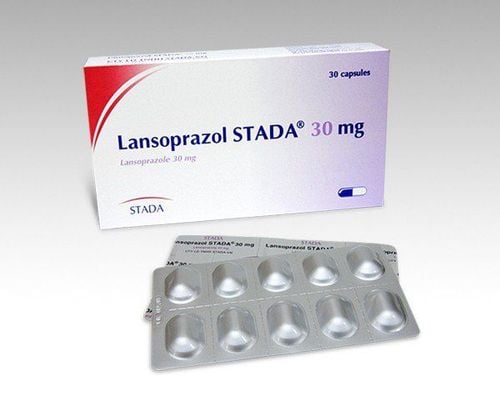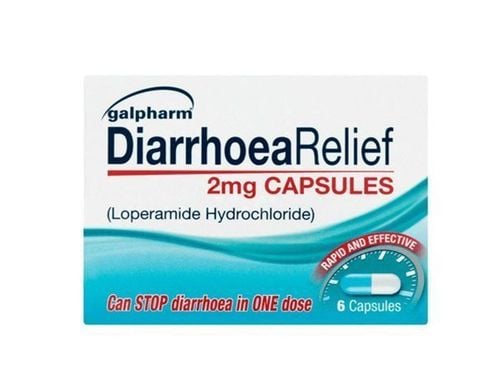This is an automatically translated article.
Arpizol is used in the treatment of gastroesophageal reflux disease - oesophagitis, peptic ulcers and Zollinger-Ellison syndrome. To use Arpizol safely and effectively, patients should consult a pharmacist or specialist before using it.
1. What is Arpizol?
Arpizol belongs to the group of gastrointestinal drugs, made in the form of capsules, packing box of 10 blisters of Alu-Alu x 10 tablets. The ingredient Omeprazole (in the form of enteric-coated mustard seeds) 20mg content in Arpizol is a specific inhibitor that works by blocking the enzyme system of Hydrogen-potassium Adenosine Triphosphatase, also known as the proton pump H + K + ATPase of gastric parietal cells. Omeprazole acts on the terminal phase of acid secretion, a single dose of 20mg/day will rapidly inhibit gastric secretion caused by any stimulant.
However, Omeprazole has no effect on acetylcholine or histamine receptors, nor does it have any significant pharmacokinetic effect other than on acid secretion. The active ingredient Omeprazole causes a long-term decrease in stomach acid, but it is reversible. 5 days after discontinuation of the drug, gastric secretion returns to normal, but there is no increase in acid secretion. Using endoscopic method showed that the scar wall rate of duodenal ulcer reached 65% after 2 weeks of treatment and 95% after 4 weeks. Omeprazole is destroyed in an acidic environment, so the drug is presented as a coated tablet that is insoluble in the stomach, absorbed only in the duodenum and small intestine. Omeprazole begins to act 1 hour after oral administration, peaks in plasma concentrations after 2 hours, and is completely absorbed after 3-6 hours. The half-life of Omeprazole is 40 minutes and does not change during treatment, the absolute bioavailability of a single dose of Omeprazole is 35%. After consecutive administration of single daily doses, bioavailability increases to 60%. Concomitant administration of Omeprazole with food has no effect on bioavailability. It is estimated that about 95% of Omeprazole is bound to plasma proteins, mainly to albumin.
Omeprazole undergoes changes in the liver. The inactive metabolites in plasma are sulfides, hydroxy omeprazole and sulfones. 80% of the metabolites are excreted in the urine, the remaining 20% in the feces.
2. Indications for taking Arpizol
Arpizol is indicated in the treatment of the following conditions:
Gastroesophageal reflux disease (GERD). Treatment of gastrointestinal ulcers. Zollinger-Ellison syndrome.
3. Dosage - How to take Arpizol
How to use:
Arpizol should be swallowed whole, do not crush or chew the tablet. If you miss a dose of Arpizol, take it as soon as you remember. If the missed dose of Arpizol is close to the next dose, skip it and take the next dose as directed. Do not take a double dose of Arpizol to make up for a missed dose. When an overdose of Arpizol, patients may appear symptoms such as nausea, vomiting, diarrhea, hearing loss. Therefore, if the patient uses an overdose of Arpizol, it is necessary to notify the doctor immediately for advice and timely treatment. Dosage for symptomatic treatment of acid indigestion:
Use Arpizol 10 or 20mg/day for 2-4 weeks. Treatment of gastroesophageal reflux syndrome (GERD):
The usual dose of Arpizol: Take 20mg x 1 time / day for 4 weeks, treat for another 4-8 weeks if the disease is not completely cured. In case of persistent esophagitis, a dose of Arpizol 40 mg/day may be used. The maintenance dose of Arpizol after esophagitis is recovered is 20mg x 1 time/day, and for acid reflux is 10mg/day. Treatment of peptic ulcers:
Single dose: Take 20mg/day or 40mg/day in severe cases. Continue treatment with Arpizol for 4 weeks for duodenal ulcers and 8 weeks for gastric ulcers. The maintenance dose of Arpizol is 10-20mg x 1 time/day. Elimination of Helicobacter pylori in peptic ulcers: Arpizol can be combined with other antibiotics in dual or triple therapy: Dual therapy: Arpizol 20mg twice daily for 2 weeks. Triple therapy: Arpizol 20mg twice daily for 1 week. Treatment of peptic ulcers caused by non-steroidal anti-inflammatory drugs:
Arpizol 20mg/day is used as a preventive measure in patients with a history of gastrointestinal injury requiring continued treatment with peptic ulcer. non-steroidal anti-inflammatory drugs. Zollinger-Ellison syndrome:
Use Arpizol 60mg once a day, adjust dose as needed. Most patients are effectively controlled at Arpizol 20-120 mg/day, but up to 120 mg 3 times/day can be used. The daily dose of Arpizol above 80mg should be divided into 2 times. Prevention of acid aspiration during general anesthesia:
Arpizol 40mg the evening before surgery and an additional 40mg 2-6 hours before the procedure. Patients with impaired renal function:
No dose adjustment of Arpizol is required in patients with impaired renal function. Patients with hepatic impairment:
Arpizol dose 10-20mg/day. Elderly (> 65 years old):
No dose adjustment of Arpizol is required in the elderly. Children:
Experience in the treatment of Arpizol in children is limited. Note: The above dose of Arpizol is for reference only. The specific dose of Arpizol depends on the condition and the progression of the disease. To get the right dose of Arpizol, patients should consult their doctor or healthcare professional.
4. Contraindications to taking Arpizol
Do not use Arpizol in the following cases:
Patients with hypersensitivity to the active ingredient Omeprazole, Esomeprazole or other Benzimidazole derivatives or any of the ingredients in Arpizol. Contraindications are absolute. This means that Arpizol can not be used for any reason in cases of contraindications. Any decision on the dose and method of taking Arpizol must be made by your doctor.
5. Arpizol side effects
Common side effects:
Headache; Sleepy; Dizzy; Nausea, vomiting; Stomachache; Diarrhea, constipation; Distention. Uncommon side effects:
Insomnia; Confusion ; Dizzy; Tired; Urticaria, skin rash, itching; Reversible increase in transaminases. Rare side effects:
Excessive sweating; Peripheral edema; Hypersensitivity such as angioedema, fever and anaphylaxis; Decrease in white blood cells, platelets and whole blood cells; Agranulocytosis; Reversible confusion; Agitation, depression; Hallucinations in elderly patients, especially in critically ill patients; Hearing disorders; gynecomastia in men; Gastritis; Candida infection; Dry mouth. Jaundice hepatitis or not; Hepatic encephalopathy; Bronchospasm; Joint/muscle pain; Interstitial nephritis. In addition to the above signs, Arpizol medicine can cause other unwanted effects. Patients should be closely monitored and advised to notify their doctor of any side effects encountered during the use of Arpizol.
6. Precautions when using Arpizol
For patients with symptoms such as weight loss, prolonged vomiting or vomiting blood, difficulty swallowing, black stools; If peptic ulcer is suspected or present, the possibility of malignancy must be excluded, since treatment with Arpizol may provide symptomatic relief and delay diagnosis. Co-administration of Arpizol with proton pump inhibitors (PPIs) and Atazanavir is not recommended. If coadministration of proton pump inhibitors and Atazanavir is deemed necessary, close monitoring of clinical manifestations such as viral infection should be associated with increasing the dose of Atazanavir to 400 mg and 100 mg of Ritonavir, but the dose of Arpizol should not be increased. . Arpizol may decrease the absorption of vitamin B12 due to a decrease or lack of hydrochloric acid. Therefore, this factor should be considered in patients with reduced body stores or at risk of reduced vitamin B12 absorption if treated for a long time. When starting or ending treatment with Arpizol, the risk of interactions with drugs metabolised by CYP2C19 should be taken into account. When monitoring drug interactions between Clopidogrel and Arpizol, the clinical correlation of this interaction is not clear. However, as a precaution, the concomitant use of Clopidogrel and Arpizol is not recommended. Severe hypomagnesaemia has been reported in patients treated with Arpizol for at least 3 months. Symptoms of severe hypomagnesaemia may include fatigue, convulsions, dizziness, muscle spasticity, delirium, and ventricular arrhythmias. These symptoms can be insidious and go unnoticed. In the majority of patients with hypomagnesaemia, the condition improves after magnesium supplementation and discontinuation of PPIs. It is important to note that magnesium levels should be measured prior to initiation and periodically during Arpizol therapy in patients requiring long-term therapy or concomitant use of digoxin or other hypomagnesaemic agents. Use of Arpizol, especially in high doses and for longer than 1 year, may slightly increase the risk of fractures, mainly in the elderly or in the presence of other risk factors. Therefore, for patients at risk of osteoporosis, care must be taken according to existing clinical guidelines, with adequate vitamin D and calcium supplementation. In experimental studies, Arpizol did not have the potential to cause malformations and toxicity to the fetus, but it should not be used during pregnancy, especially in the first 3 months. The use of Arpizol in nursing women is not recommended. Omeprazole has virtually no effect on the ability to drive or use machines. If undesirable effects such as dizziness, visual disturbances occur, the patient should not drive or operate machinery. To avoid drug interactions, before being prescribed Arpizol, patients should inform their doctor about all medicines they are using, including supplements, herbs or vitamins and minerals. The doctor will base on that to prescribe the appropriate Arpizol. Above is all information about Arpizol, patients need to carefully read the instructions for use, consult a doctor / pharmacist before using. Note, Arpizol is a prescription drug, patients need to use the drug as prescribed by the doctor, absolutely do not self-treat at home.













